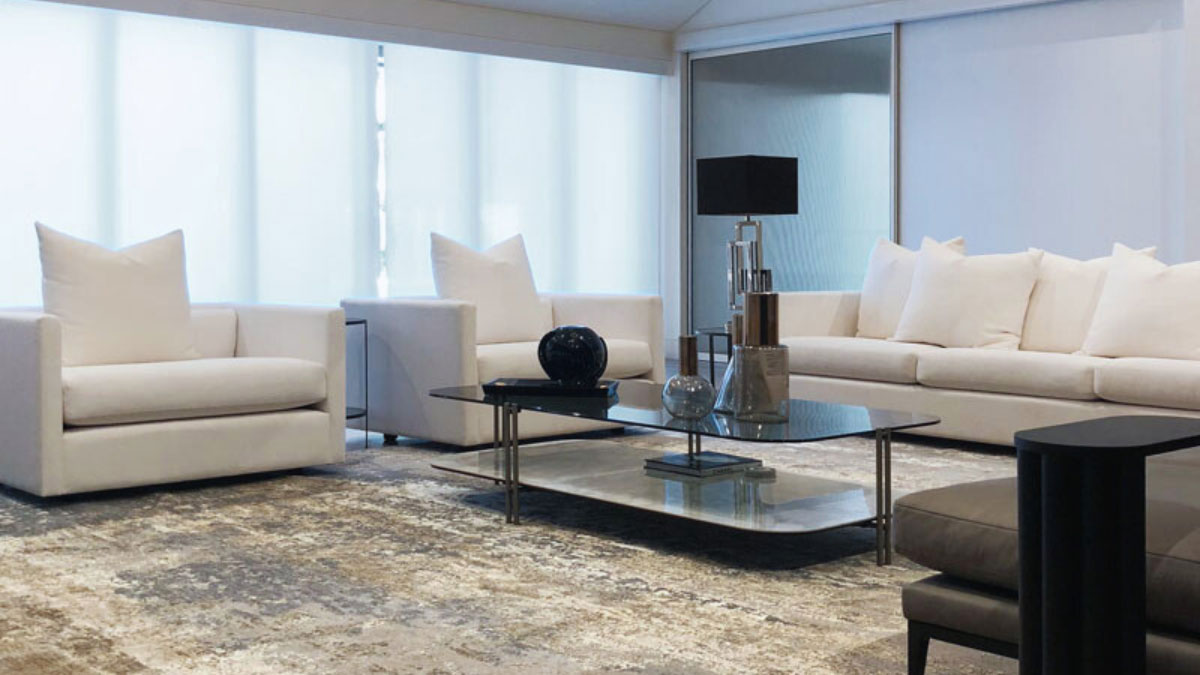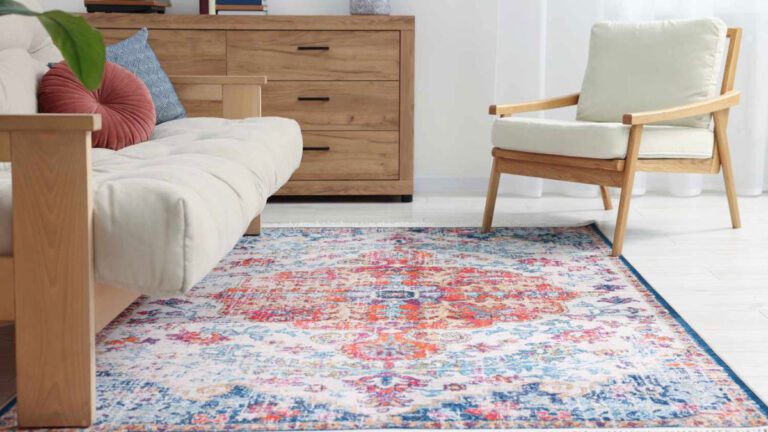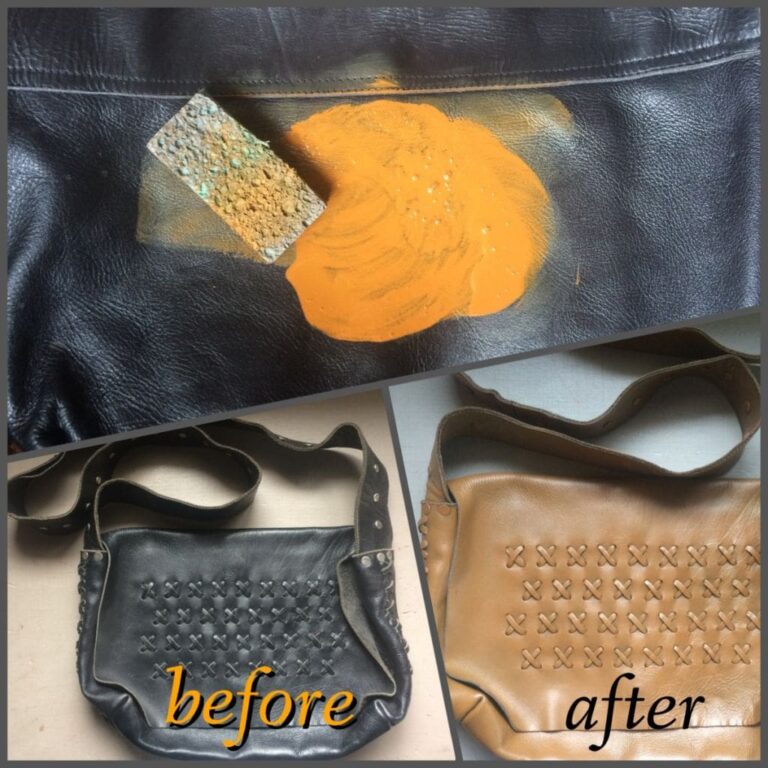Real Silk vs Art Silk Rugs: Key Differences Explained
When it comes to choosing a rug, the allure of silk is undeniable. Its luxurious feel and shimmering appearance make it a coveted choice for many. But, not all silk rugs are created equal. The market is flooded with both genuine silk and art silk rugs, and understanding the difference is crucial for making an informed purchase.
Real silk, produced by silkworms, offers a unique blend of beauty and resilience. Its natural fibers are not only strong but also exude a rich luster that sets it apart. On the other hand, art silk, made from synthetic rayon fibers, mimics the look and feel of real silk at a fraction of the cost. Even though their similar appearance, these two materials have distinct characteristics that affect their durability and maintenance.
Choosing between real and art silk rugs isn’t just about aesthetics—it’s about investing in quality and longevity. Understanding these differences ensures you select a rug that meets your style and practical needs.
Key Takeaways
- Material Distinction: Real silk rugs are crafted from natural silkworm cocoons, offering superior strength and a distinct, luxurious sheen. In contrast, art silk rugs are made from synthetic fibers like rayon, providing a similar appearance at a lower cost but with reduced durability.
- Durability and Longevity: Genuine silk rugs are known for their durability due to their natural protein composition. Conversely, art silk rugs, while visually appealing, generally have a shorter lifespan and are not suitable for high-traffic areas.
- Aesthetic and Texture Variations: Real silk rugs are prized for their high knot count and dynamic luster that changes with light, while art silk rugs, although glossy, often have a stiffer texture and less vibrant color shifts.
- Cost Considerations: Art silk rugs offer a budget-friendly alternative to real silk, which can be significantly more expensive due to its intensive production process. However, this cost-saving comes at the expense of longevity and texture quality.
- Identification Tips: Key methods to distinguish real from art silk rugs include assessing the thickness, sheen, and texture through tactile examination, as well as observing the fringe integration and color vibrancy.
- Maintenance Requirements: Proper care for silk rugs involves gentle handling, periodic professional cleaning, avoiding moisture, and minimizing direct sunlight exposure to maintain their appearance and prevent color bleeding.
Understanding Silk Rugs
Silk rugs captivate with their intricate designs and luxurious feel. Distinguishing between real silk and art silk is crucial, as each offers unique characteristics and quality attributes.
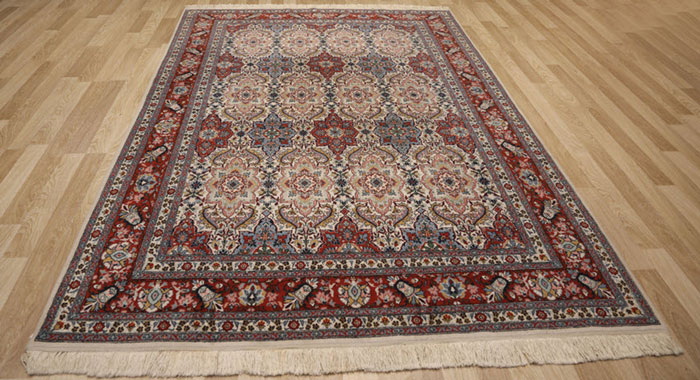
Real Silk Rugs
- Origin and Production: Real silk comes from silkworm cocoons, specifically the Asian or mulberry silk moth. The labor-intensive process involves boiling the cocoons and unraveling them into continuous filaments. This slow production results in higher costs.
- Characteristics: Renowned for exceptional tensile strength, real silk exceeds nylon strength, offering rich, saturated colors and a unique, translucent luster. These rugs are thin yet finely crafted, with high knot counts, often surpassing 1,500 knots per square inch. They feel warm to the touch and exhibit a natural sheen, changing with your viewing angle.
- Composition: Art silk, short for artificial silk, usually comprises rayon or mercerized cotton. These materials mimic the look and feel of genuine silk but at a reduced cost.
- Features: Art silk rugs possess a sheen similar to real silk but lack the same tensile strength and longevity. They offer a visually appealing option but can’t match the durability of real silk rugs.
Understanding these differences allows you to choose a silk rug that aligns with your preferences for quality, appearance, and budget.
Key Differences Between Real and Art Silk Rugs
Understanding the distinctions between real and art silk rugs helps you make informed decisions about quality and aesthetics. These differences profoundly impact material composition, durability, longevity, appearance, and texture, guiding your choice according to personal preferences and practical needs.

Material Composition
Real silk rugs use silk fibers derived from the cocoons of Asian or mulberry silk moths. The fibers are unraveled from the cocoons through a labor-intensive process, resulting in a luxurious texture. Conversely, art silk rugs comprise materials like viscose, mercerized cotton, wild silk, and rayon blends. They mimic silk’s appearance at a lower cost but don’t match the natural silk’s purity.
Durability and Longevity
Real silk rugs offer remarkable strength and durability due to their natural protein composition, which includes amino acids. With proper care, they maintain their appearance for years. Art silk rugs, featuring synthetic rayon fibers, are less robust and wear out more quickly. While they provide an attractive look initially, they may not withstand high foot traffic or frequent cleaning.
Appearance and Texture
Genuine silk rugs typically have a higher knot count, up to 1,500 knots per square inch, making them incredibly detailed and smooth. They exhibit a rich, shimmering sheen that changes with light and user position, offering a distinct aesthetic appeal. Art silk rugs attempt to replicate this polished look but fall short in texture and luster, offering a more rigid feel and less dynamic color change across different viewpoints.
Benefits and Drawbacks of Real Silk Rugs
Experience the elegance and enduring appeal of real silk rugs, known for their beauty and intricacy. Discover both the captivating benefits and notable challenges of maintaining these luxurious creations.
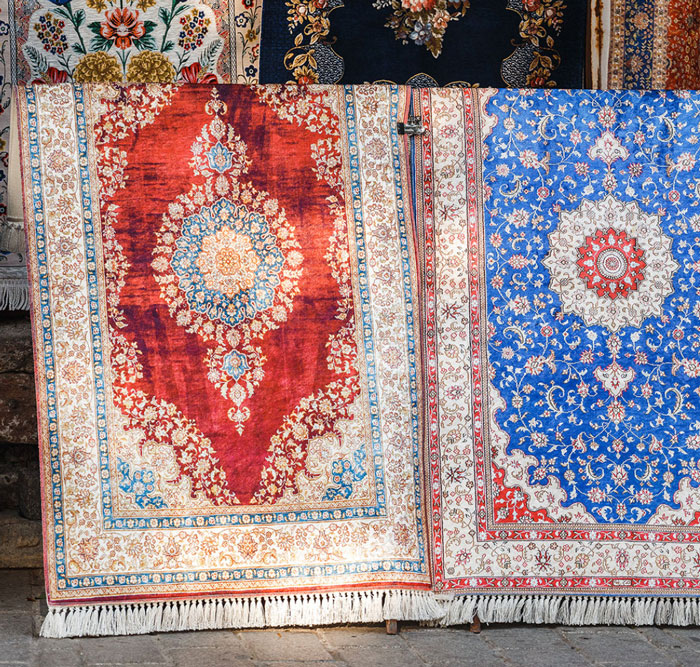
Luxurious Feel and Appearance
- Real silk rugs offer exceptional strength and beauty with fibers derived from silkworm cocoons.
- They exhibit a distinctive luster and rich colors that shift with light.
- Intricate designs are possible due to high knot counts, often exceeding 1,500 knots per square inch.
- Due to their delicate nature, real silk rugs require careful handling and maintenance.
- They can be easily damaged by foot traffic, ideal for display as art pieces or wall textiles.
- Professional cleaning is usually necessary to preserve their condition and sheen.
Pros and Cons of Art Silk Rugs
Art silk rugs offer an alternative to real silk at a lower cost, with both benefits and drawbacks.
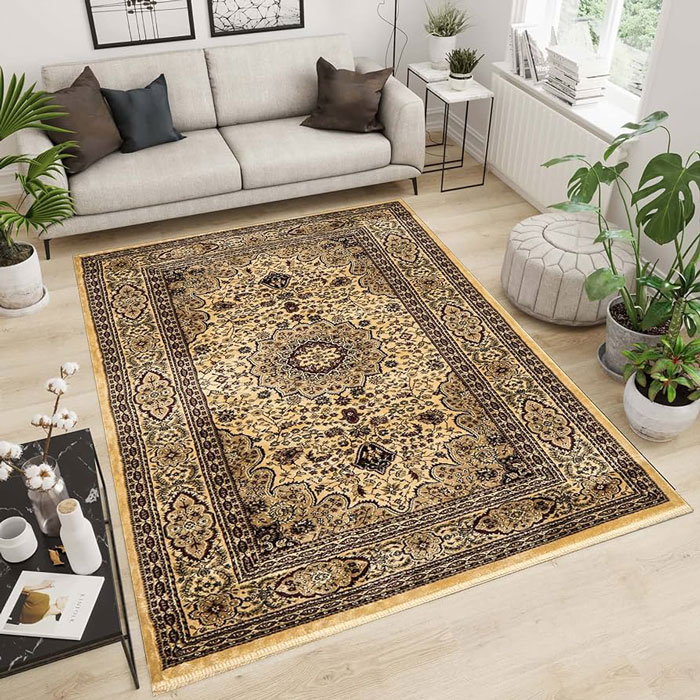
Cost-Effectiveness
Art silk rugs provide a budget-friendly option compared to real silk. Real silk can cost approximately 45 times more than art silk due to the labor-intensive production process. This makes art silk appealing for those seeking the luxurious look of silk without the expense. While the initial investment is lower, art silk requires professional cleaning by trained professionals to maintain its appearance.
Issues with Shedding and Stiffness
Art silk rugs, made from materials like rayon or viscose, often face shedding and stiffness challenges. As these synthetic fibers attempt to mimic natural silk, they can be prone to fiber release, leading to a less smooth surface over time. The stiff fibers also result in a texture that lacks the pliability and sheen of real silk rugs. When selecting art silk, it’s crucial to consider these aspects, especially for areas with high foot traffic, to ensure longevity and maintain its decorative appeal.
How to Identify Real vs Art Silk Rugs
Identifying real vs art silk rugs involves examining several characteristics through visual and tactile assessments. Understanding these distinctions ensures informed purchasing decisions.
Visual Inspection
- Thickness and Pile: Real silk rugs exhibit a thin and pliable construction with a high density of knots, often exceeding 200 knots per square inch and reaching up to 1,500. In comparison, art silk rugs are thicker with a knot count generally below 250.
- Sheen and Color: Genuine silk rugs possess a distinctive sheen and vibrant colors that vary with the angle of light, offering a dynamic appearance. Art silk, usually made from rayon or viscose, has a duller color spectrum and lacks the reflective luster.
- Fringe: The fringe on real silk rugs seamlessly integrates as part of the rug’s structure, being an extension, whereas art silk rugs often feature sewn-on cotton fringe.
- Temperature of Touch: When rubbed vigorously, real silk feels warm due to its natural fiber properties, while art silk feels cold due to synthetic composition.
- Texture: Running your hand across a real silk rug reveals a smooth, luxurious texture, highlighting its premium quality. Art silk, although mimicking silk’s softness, may feel less lush and slightly stiffer.
Through these inspection methods, distinguishing between real and art silk rugs becomes more accessible, allowing you to appreciate the craftsmanship and value of your choice.
Caring for Silk Rugs
Caring for silk rugs involves a gentle approach to maintain their beauty and structure. These delicate textiles require specific techniques to ensure longevity and preserve their luxurious appeal.
Cleaning and Maintenance Tips
Effective cleaning and maintenance are crucial for silk rugs. Regular care can help maintain their vibrant colors and intricate designs.
- Vacuum gently: Use a brushless vacuum attachment to prevent fiber damage.
- Spot clean immediately: Blot spills with a clean cloth; avoid scrubbing which can cause fiber abrasion.
- Rotate periodically: To ensure even wear and prevent fading from sunlight exposure, periodically rotate the rug.
- Professional cleaning: Schedule cleaning by specialists every 1-2 years. They use techniques suited for silk fibers, preserving their condition.
Preventing Color Bleeding
Color retention is vital for maintaining the aesthetic of silk rugs. Proper precautions prevent dyes from bleeding.
- Avoid water exposure: Moisture can cause dyes to run. Always dry spill areas promptly using a fan or indirect sunlight.
- Test cleaning products: Before applying any cleaning agents, test them on a hidden corner. Opt for pH-neutral products to reduce acidity that may affect dyes.
- Limit sunlight exposure: Prolonged direct light can fade colors. Use UV-blocking window treatments to minimize exposure.
Recognizing the intricacies of caring for silk rugs enhances their lifespan, allowing you to enjoy their exquisite beauty year after year.
Conclusion
Choosing between real silk and art silk rugs depends on your priorities and budget. Real silk offers unmatched luxury and durability with its vibrant colors and intricate designs, making it a worthwhile investment for those who appreciate fine craftsmanship. But, it requires careful maintenance and is best suited for low-traffic areas or as decorative pieces.
On the other hand, art silk provides an affordable alternative that mimics the elegance of real silk without the hefty price tag. While it lacks the same durability and sheen, art silk rugs can still enhance your space beautifully if you’re mindful of their care and placement. Eventually, understanding the differences and maintenance needs helps you make an well-informed choice that aligns with your lifestyle and aesthetic preferences.
Frequently Asked Questions
How can I identify a real silk rug from an art silk rug?
Real silk rugs are thinner, more pliable, and exhibit a vibrant sheen with colors that shift with light. They also have a high knot count, often with intricate designs. In contrast, art silk rugs are thicker, have a duller finish, and might feature sewn-on cotton fringe. Examining these characteristics can help differentiate between genuine silk and art silk rugs.
What are the main advantages of real silk rugs?
The main advantages of real silk rugs include their luxurious texture, exceptional tensile strength, and intricate designs due to high knot counts. They showcase a beautiful luster and rich colors that shift with light. However, they require careful handling and are best suited for low-traffic areas or as decorative pieces.
Are art silk rugs durable?
Art silk rugs are less durable than their genuine counterparts. They may wear out more quickly, especially in high-traffic areas. Although they offer an affordable silk-like appearance, they can suffer from shedding and a stiffer texture over time.
Why are real silk rugs more expensive?
Real silk rugs are more expensive due to the labor-intensive process of weaving and the quality of the silk fibers. The craftsmanship, intricate knot patterns, and unique luster contribute to the higher cost, making them a luxury item.
How should I care for a real silk rug?
To care for a real silk rug, avoid exposing it to water and direct sunlight. Use a brushless vacuum attachment for gentle cleaning, spot clean spills immediately, rotate the rug periodically to prevent uneven wear, and schedule professional cleaning every 1-2 years to maintain its beauty.
Can art silk maintain a similar appearance to real silk?
Art silk can mimic the look of real silk, offering a luxurious appearance at a lower price. However, it lacks the same sheen and pliability. With professional cleaning, art silk rugs can maintain their look but may eventually develop issues like stiffness and fiber release.
What are some drawbacks of art silk rugs?
Art silk rugs, while budget-friendly, may have a stiffer texture and can shed fibers over time. They also do not match the strength and longevity of real silk. These factors make them less suitable for high-traffic areas.
What is the composition of art silk rugs?
Art silk rugs are made from synthetic fibers like rayon or mercerized cotton, designed to mimic the appearance of real silk. While they offer a silk-like aesthetic, they lack the strength and natural luster of genuine silk rugs.

